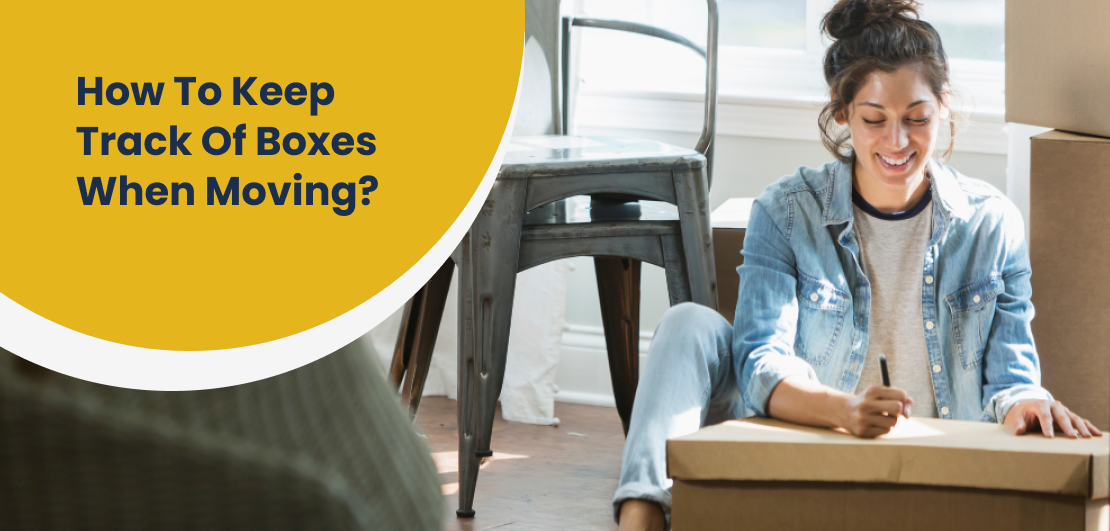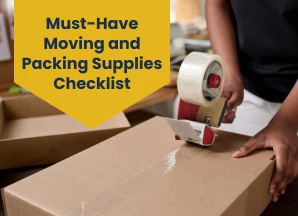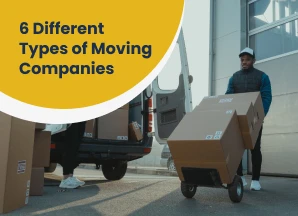How to Keep Track of Boxes When Moving?

Packing up everything for a move can quickly turn into a game of "Where did I put that?" But don’t worry! With a little planning, smart labeling, and some simple tricks, you can stay on top of your boxes and avoid the stress of losing track of your belongings.
Here’s how you can stay organized, keep track of your belongings, and make your move a lot easier!
Why Keeping Track of Boxes Is Important?
When moving, it’s not just about packing everything into boxes and getting it to your new home. It's about making sure that your belongings arrive safely, are easy to find when you need them and are organized enough for an efficient unpacking process.
Imagine arriving at your new home, and you can’t find your toiletries or your child's favorite toy have gone missing because they were packed in the wrong box. You can avoid stress, wasted time, and frustration by keeping track of your boxes and their contents.
How to Organize Boxes When Moving?
When it comes to organizing boxes during a move, the key is preparation. This isn’t just about throwing things in boxes and labeling them. With a bit of effort and a solid plan, you can save yourself a lot of headaches later on. Here are some practical tips to organize your boxes efficiently:
1. Create a Moving Checklist
Every move begins with planning - and your moving checklist is the blueprint to guide you through the entire process. It’s easy to forget something amidst the chaos, but with a well-thought-out checklist, you won’t miss a beat. Your checklist should include:
- Packing tasks: List each room and note what needs to be packed.
- Moving company arrangements: If you’re hiring professionals, confirm the details with your moving company well in advance.
- Supplies: Make sure you have enough boxes, packing materials, tape, and labels before you start packing.
Make your moving checklist as detailed as possible and update it as you check off tasks. It will help you stay organized every step of the way.
Labeling your boxes is an absolute must when moving. It’s the simplest way to keep track of what’s inside and where each box should go in your new home. A good labeling system can make your move much smoother. Here’s how to do it effectively:
- Use a color-coded method: Assign each room in your house a different color (e.g., blue for the kitchen, red for the living room, etc.). Use colored markers or stickers to label each box based on its room.
- Write a brief description of the contents:Instead of just writing “kitchen,” be more specific. Write “kitchen - pots and pans” or “kitchen - dishes” so you can easily identify the box.
- Mark fragile boxes: If a box contains fragile items, clearly mark it with "FRAGILE" on multiple sides to ensure it’s handled with care.
3. Label with Descriptions (Not Just “Kitchen”)
When labeling your boxes, avoid vague terms like “Kitchen” or “Living Room.” Instead, be more specific about the contents. This extra detail will help you when it’s time to unpack.
For example, instead of just writing “Kitchen,” try:
- “Kitchen - Dishes and Glasses”
- “Kitchen - Pots, Pans, and Utensils”
The more specific you are, the easier it will be to find exactly what you need when you arrive at your new home.
4. Use a Numbering System for Each Box
In addition to labeling, you can assign each box a number (e.g., Box #1, Box #2, etc.). Include this number on your inventory list along with a description of what’s inside. This will make it even easier to track all your boxes and locate specific items when you need them.
If you’re working with a moving company, you can give them the numbered list too, so they know which boxes belong to which room in the new home. A simple numbering system adds another layer of organization, especially if you have a large number of boxes.
Tip: At Van Lines Move, we know that every move is unique, which is why we offer personalized moving services to meet your specific needs. Whether you're moving locally or long-distance, our experienced movers ensure that every detail is taken care of, from packing and loading to safe transportation and unloading. We’re committed to providing reliable, efficient, and affordable moving services, ensuring your belongings arrive safely and on time. Let us help you make your next move a smooth and seamless experience.
5. Pack Similar Items Together
When packing, make sure you pack similar items together to reduce confusion. For example, pack all of your bathroom items in one box (towels, toiletries, cleaning supplies) and all of your kitchen items in another. This way, when you need something, you’ll know exactly where to find it.
Packing similar items together also helps prevent cross-contamination. You don’t want your books to get damaged by a spilled bottle of shampoo, so always pack items that could potentially leak or spill separately and securely.
6. Use Sturdy Boxes and Packing Materials
The safety of your belongings during transit is just as important as keeping track of them. Be sure to use sturdy, high-quality boxes to avoid breakage or damage. When packing delicate or fragile items, use bubble wrap, packing peanuts, or old newspapers for extra cushioning.
In addition, make sure to tape the boxes securely and reinforce the bottoms to prevent anything from falling out. If you’re hiring a moving company, let them know if any boxes contain fragile items so they can handle them with care.
Moving doesn’t have to be stressful if you're organized from the start. With a solid moving checklist, smart labeling, and a good inventory system, you’ll stay on top of your boxes and avoid confusion. Whether you’re doing it yourself or hiring professional movers, preparation is key to an easy move.
A detailed checklist for moving helps you stay on track with all tasks, from packing to unpacking. By labeling your boxes and using a numbering system, you'll ensure that your belongings are easily accessible when you arrive at your new home.
A little effort in the beginning will save you time and stress during your move. With the right method, you’ll be settled into your new home in no time!
Categories
- Long Distance Moving145
- Local Moving116
- Commercial Moving38
- Residential Moving30
- Last – Minute Moving25
- Furniture Moving8
- Moving Cost Calculator5
- Piano Moving3
- Car Transportation3
- Truck Rental3
- Moving Cost3
- Local Move3
- best moving rates3
- cheap moving companies3
- affordable moving companies3
- Junk Removal2
- Senior Moving2
- Senior Relocation Moving Companies2
- Moving Tools2
- Moving Estimates2
- Moving companies2
- Moving services2
- state to state movers2
- Heavy Equipment1
- Moving Container1
- Senior Moving Services1
- moving tips1
- office moving1
- office relocation1
- employee relocation1
- Car Transport1
- Vehicle Shipping1
- Car Shipping Services1
- Artificial Intelligence1
- Office Moving Services1
- Commercial Moving Companies1
- Corporate Moving Services1
- Corporate Movers1
- interstate moving1
- full-service movers1
- full-service moving companies1

 Local Movers
Local Movers Last-Minute Movers
Last-Minute Movers Junk Removal
Junk Removal Long Distance Movers
Long Distance Movers Piano Movers
Piano Movers Heavy Equipment
Heavy Equipment Commercial Movers
Commercial Movers Moving Container
Moving Container Car Transportation
Car Transportation Furniture Movers
Furniture Movers Truck Rental
Truck Rental Moving Cost Calculator
Moving Cost Calculator Moving Planner
Moving Planner Packing Calculator
Packing Calculator Moving Checklist
Moving Checklist Moving Insurance
Moving Insurance FAQ
FAQ Contact Us
Contact Us Moving Loan
Moving Loan About Us
About Us








